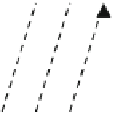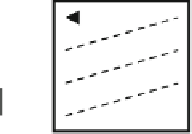Graphics Reference
In-Depth Information
Fig. 8.15
Regions in 8
8;
Low Frequency
(DC 4x4 subblock)
16
32 TBs map
to different context sets for
SIG
16 and 32
DC
X
F
B
I
E
H
Mid to High
Frequency
(Non-DC subblock)
0 = diagonal
1 = horizontal
2 = vertical
Fig. 8.16
Diagonal, vertical, and horizontal scans for 4
4 TBs
Tabl e 8. 8
Mode dependent coefficient scanning: Mapping of intra prediction mode to scans
(0
D
Diagonal, 1
D
Horizontal, 2
D
Vertical) for different TB sizes and components
Intra Prediction Mode
0 (Planar) 1(DC) 2 3 4 5
6to14 15 to 21 22 to 30 31 to 34
8
8 (luma)
0
0
2
0
1
0
4
4 (luma or chroma) TB 0
0
2
0
1
0
Otherwise
0
coded_sub_block_flag
(CSBF). In HM8.0, 8
8 TBs were also divided into
4
4 subblocks such that all TB sizes above 4
4 are based on a 4
4 subblock
processing for a harmonized design [
77
].
The 8
8; 16
16 and 32
32 TBs are divided into three regions based on
frequency, as shown in Fig.
8.15
. The DC, low-frequency and mid/high-frequency
regions all use different sets of contexts. To reduce memory size, the contexts for
coding the SIG of 16
16 and 32
32 TBs are shared [
81
,
99
].
For improved coding efficiency for intra predicted CUs, so-called mode depen-
dent coefficient scanning (MDCS) is used to select between vertical, horizontal,
and diagonal scans based on the chosen intra prediction mode [
106
], as illustrated
in Fig.
8.16
.Table
8.8
shows how the scans are assigned based on intra prediction
mode, TB size, and component. As mentioned in Sect.
8.5.2
, this requires the intra
mode to be decoded before decoding the corresponding transform coefficients.
MDCS is only used for 4
4 and 8
8 TBs and provides coding gains of up
to 1.2 %. Note that for TBs larger than 8
8; and for TBs of inter predicted CUs,
only the diagonal scan is used.











































































































































